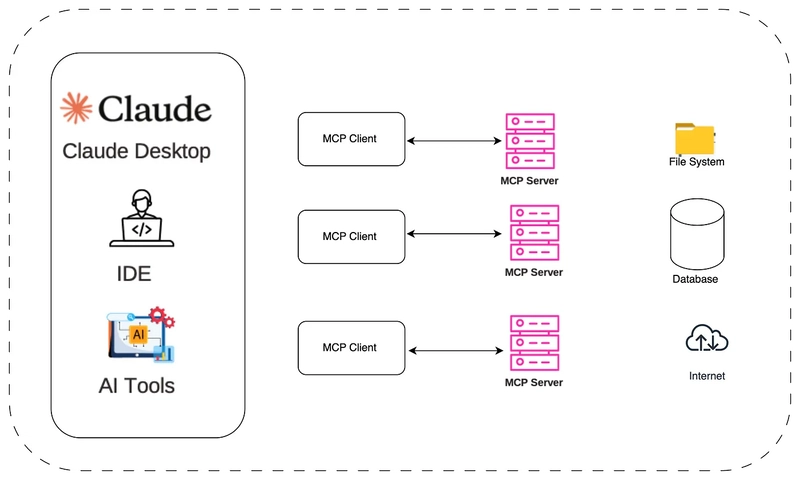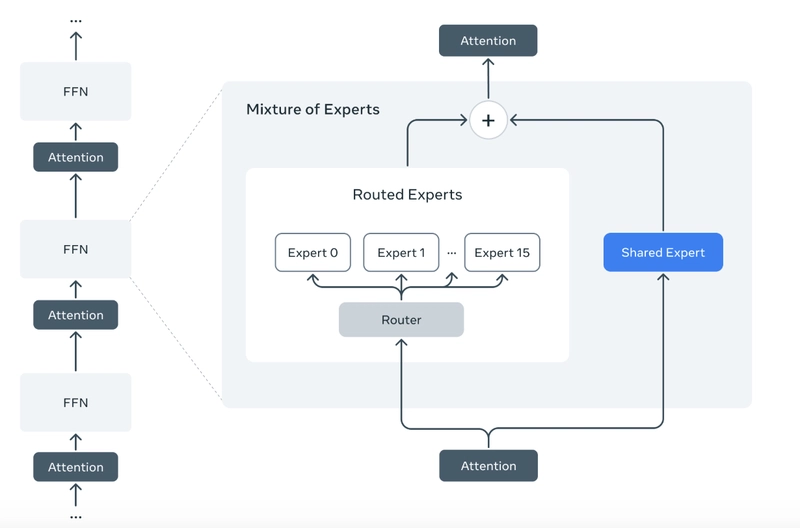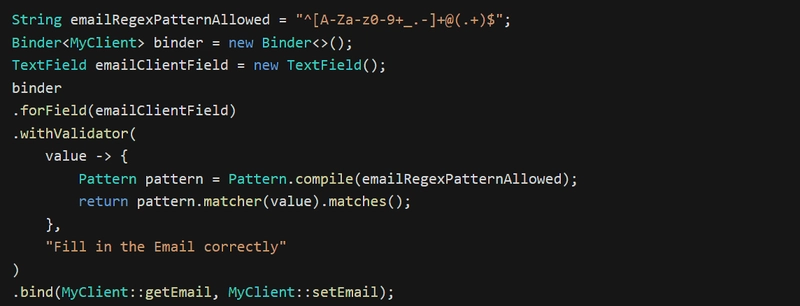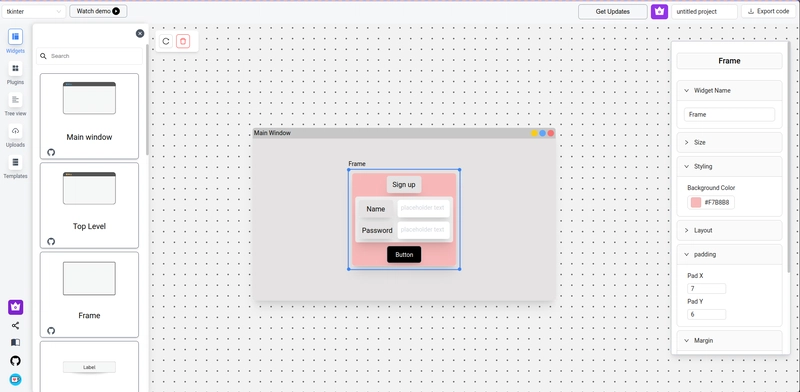Introduction to Data Validation in Vaadin Forms – part 1
Introduction This article is part of the series: 'Towards Vaadin Developer Certification,' which aims to explain the fundamentals of Vaadin while I study for this certification. The topics covered here are an integral part of the 'Vaadin Developer' Certification. The article was based on my notes. In the real world, we seek active data from various sources. This is obvious. However, the task is not so simple when we need to validate the data entered in the fields. We are not talking about business rules here, but rather about strictly validating the data typed in the field. We will include validation parameters so that validation occurs at the time of typing. First Steps with Validators We want to assign validation resources to our fields. Positive or negative values, certain admissible patterns in typing, such as restrictions related to numbers or text, can be applied as properties of the field in Vaadin. a) Vaadin Default Validators There are several ways to assign validation to a field in Vaadin. Let's see an example: The .bind method finalizes the chain. Therefore, the validators will come before this finalization. No validator is allowed in the shortcut: b) Lambda Functions Another form of validation is using lambda functions. This allows inserting programming logic within the validator. See an example with Regex: c) "Not Null" and "Not Empty" Validation We can check if the fields are empty or null using as Required: d) Custom Validations We can create our own custom validations. See an example: Conclusion Data validation in Vaadin forms is essential to ensure data integrity. With the various available techniques, we can create robust and efficient forms. In the next article, we will explore more about Vaadin's built-in validators and how to customize error messages. • Disclaimer This content, although based on my studies and notes acquired during the Vaadin 24 certification process, does not intend to be exhaustive. For a deeper understanding of the topic, I recommend consulting the official Vaadin 24 documentation and the materials from the certification courses. Additionally, I would like to inform you that I used Artificial Intelligence tools to assist in the modeling and structuring of this article. However, the writing and the original content are exclusively authored by me, hence AI was utilized as a helpful tool, not as a replacement for my own authorship. Authors Paulo B. A. is an 'Oracle Certified Java Developer' and 'Spring Certified Professional' with a deep passion for Vaadin Flow. He crafts UIs with Vaadin and strives to make it the leading frontend framework for full-stack Java developers worldwide. He loves teaching, sharing knowledge, and creating content. While he enjoys learning theory through certifications, he always advocates for a practical approach. • Linkedin.com/in/pbalves • X.com/p_b_alves • Mastodon.social/@pbalves Staff Writer: Fábio A. P. is a technology enthusiast, self-taught writer, and scholar of society's relationship with technology. Passionate about sharing insights, he provides reliable perspectives on how technology shapes our lives. With clear and precise writing, Fábio simplifies complex topics, empowering readers to navigate the digital age with confidence. • Medium.com/@fabioape

Introduction
This article is part of the series: 'Towards Vaadin Developer Certification,' which aims to explain the fundamentals of Vaadin while I study for this certification. The topics covered here are an integral part of the 'Vaadin Developer' Certification. The article was based on my notes.
In the real world, we seek active data from various sources. This is obvious. However, the task is not so simple when we need to validate the data entered in the fields.
We are not talking about business rules here, but rather about strictly validating the data typed in the field. We will include validation parameters so that validation occurs at the time of typing.
First Steps with Validators
We want to assign validation resources to our fields. Positive or negative values, certain admissible patterns in typing, such as restrictions related to numbers or text, can be applied as properties of the field in Vaadin.
a) Vaadin Default Validators
There are several ways to assign validation to a field in Vaadin. Let's see an example:
The .bind method finalizes the chain. Therefore, the validators will come before this finalization. No validator is allowed in the shortcut:
b) Lambda Functions
Another form of validation is using lambda functions. This allows inserting programming logic within the validator. See an example with Regex:
c) "Not Null" and "Not Empty" Validation
We can check if the fields are empty or null using as Required:
d) Custom Validations
We can create our own custom validations. See an example:
Conclusion
Data validation in Vaadin forms is essential to ensure data integrity. With the various available techniques, we can create robust and efficient forms. In the next article, we will explore more about Vaadin's built-in validators and how to customize error messages.
• Disclaimer
This content, although based on my studies and notes acquired during the Vaadin 24 certification process, does not intend to be exhaustive. For a deeper understanding of the topic, I recommend consulting the official Vaadin 24 documentation and the materials from the certification courses.
Additionally, I would like to inform you that I used Artificial Intelligence tools to assist in the modeling and structuring of this article. However, the writing and the original content are exclusively authored by me, hence AI was utilized as a helpful tool, not as a replacement for my own authorship.
Authors
Paulo B. A. is an 'Oracle Certified Java Developer' and 'Spring Certified Professional' with a deep passion for Vaadin Flow. He crafts UIs with Vaadin and strives to make it the leading frontend framework for full-stack Java developers worldwide. He loves teaching, sharing knowledge, and creating content. While he enjoys learning theory through certifications, he always advocates for a practical approach.
• Linkedin.com/in/pbalves
• X.com/p_b_alves
• Mastodon.social/@pbalves
Staff Writer: Fábio A. P. is a technology enthusiast, self-taught writer, and scholar of society's relationship with technology. Passionate about sharing insights, he provides reliable perspectives on how technology shapes our lives. With clear and precise writing, Fábio simplifies complex topics, empowering readers to navigate the digital age with confidence.
• Medium.com/@fabioape









































































































































































![[The AI Show Episode 142]: ChatGPT’s New Image Generator, Studio Ghibli Craze and Backlash, Gemini 2.5, OpenAI Academy, 4o Updates, Vibe Marketing & xAI Acquires X](https://www.marketingaiinstitute.com/hubfs/ep%20142%20cover.png)


























































































































![[FREE EBOOKS] The Kubernetes Bible, The Ultimate Linux Shell Scripting Guide & Four More Best Selling Titles](https://www.javacodegeeks.com/wp-content/uploads/2012/12/jcg-logo.jpg)



![From drop-out to software architect with Jason Lengstorf [Podcast #167]](https://cdn.hashnode.com/res/hashnode/image/upload/v1743796461357/f3d19cd7-e6f5-4d7c-8bfc-eb974bc8da68.png?#)







































































































.png?#)




.jpg?#)
































_Christophe_Coat_Alamy.jpg?#)
 (1).webp?#)








































































































![Rapidus in Talks With Apple as It Accelerates Toward 2nm Chip Production [Report]](https://www.iclarified.com/images/news/96937/96937/96937-640.jpg)












































































































































